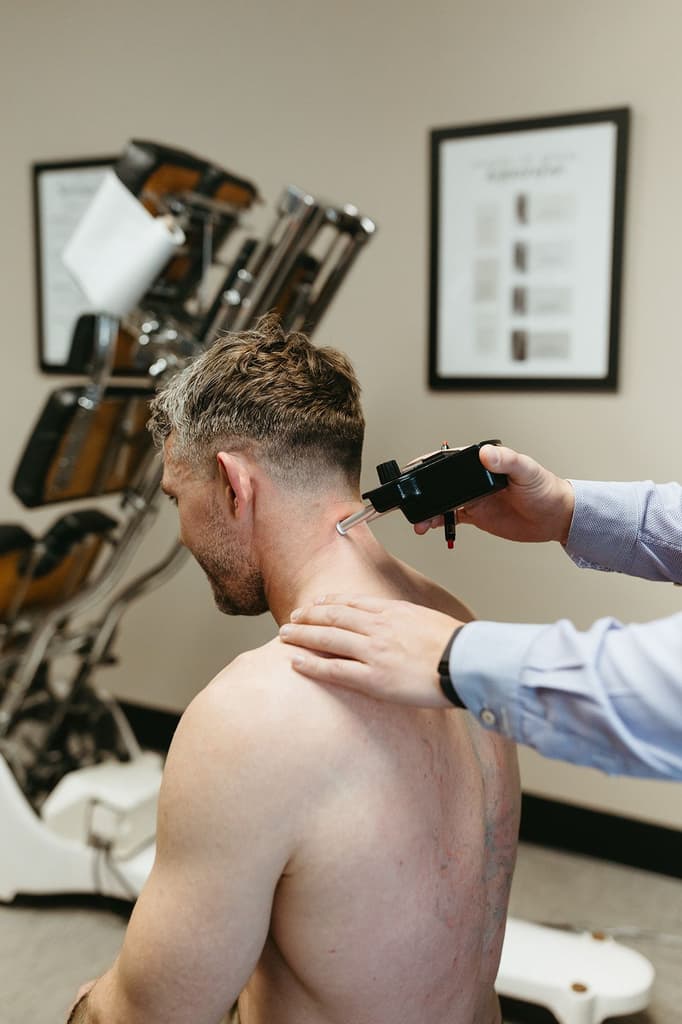The Gonstead Method is a chiropractic approach designed to identify and correct specific spinal misalignments, improving overall spinal and nervous system health. Developed by Dr. Clarence Gonstead in the 1920s, this technique uses a five-step diagnostic process: visual inspection, instrumentation (Nervoscope), static and motion palpation, and X-ray analysis. The adjustments are precise, avoiding unnecessary manipulations, and focus on restoring proper alignment and intervertebral disc health.
Key takeaways:
- Misalignments (subluxations) can disrupt nerve function and lead to health issues.
- The Gonstead Method addresses the root cause of spinal problems, not just symptoms.
- Tools like full-spine X-rays and the Nervoscope ensure accuracy in diagnosis.
- Adjustments are performed with controlled, targeted techniques to minimize risks.
For those seeking personalized spinal care, clinics like Kinnection Clinic combine Gonstead expertise with additional therapies, offering tailored solutions for long-term health.
THE GONSTEAD DIFFERENCE – PART 1 (THE EXAM) BY DR. WALLER GONSTEAD CHIROPRACTOR
Core Components of Gonstead Spinal Analysis
Dr. Gonstead dedicated decades to perfecting his system, conducting over 1.2 million office visits. Through this extensive experience, he developed a systematic approach to assess and address spinal misalignments.
Visual Assessment Techniques
Visual assessment is a cornerstone of the Gonstead method, offering insights into structural imbalances that might not be immediately obvious. This involves observing the patient’s posture, gait, and the alignment of ear, shoulder, and hip heights. These observations help identify potential misalignments and areas of dysfunction. For example, practitioners examine how well the hips, shoulders, and base of the skull are aligned, looking for abnormal patterns. Additionally, they analyze upper and lower extremity movements while the patient stands and walks, providing a clearer picture of spinal biomechanics. When combined with X-rays and palpation, these visual assessments contribute to a comprehensive diagnostic framework. The findings from this process help guide the use of specialized diagnostic tools to pinpoint the exact areas of concern.
Diagnostic Tools and Equipment
The Gonstead Method relies on advanced tools to detect nerve pressure and inflammation, building on the foundation of visual assessments. One key instrument is the differential skin temperature meter, commonly called the Nervoscope, which helps identify inflammation and nerve pressure along the spine. Research into devices like the TyTron C-3000 has shown high reliability in paraspinal thermal scans, with ICC values ranging from 0.91 to 0.98.
Additionally, Gonstead practitioners use specialized adjustment tables designed for precision and patient comfort. A typical equipment setup includes a Pelvic bench, Cervical chair, and Knee Chest table, with a complete set costing about $2,400. These tools enable the precise, short-lever, high-velocity, and low-amplitude adjustments that define the Gonstead approach.
Hands-On Examination and X-ray Analysis
The combination of manual examination and X-ray analysis creates a thorough diagnostic process in the Gonstead system. Palpation, both static and dynamic, helps practitioners detect changes in contour, tone, texture, and temperature, pinpointing areas of concern [20–23]. Full spine X-rays are another critical component, providing a detailed view of spinal alignment under weight-bearing conditions [20–23]. These X-rays not only allow for accurate vertebral counts but also reveal underlying issues that might not be immediately linked to the patient’s primary complaint [20–23].
The Gonstead Method uses a 14″ x 36″ film size to capture the full spinal anatomy, from the ischium to the occiput, in both anterior-posterior and lateral views. This approach minimizes radiation exposure compared to sectional X-rays [20–23].
Dr. Gonstead stressed the importance of precision in spinal adjustments, warning that even a few incorrect adjustments could create a subluxation. To avoid this, the method integrates findings from visualization, instrumentation, palpation, X-ray, and patient symptoms to determine the exact area to adjust [21–23]. By cross-referencing these diagnostic tools, practitioners can pinpoint the root cause of the patient’s issue with remarkable accuracy. This meticulous process ensures targeted adjustments and tailored treatment plans, setting the Gonstead Method apart from other chiropractic approaches.
Step-by-Step Gonstead Analysis Process
The Gonstead Method uses a structured 5-step process: Visualization, Instrumentation, Static Palpation, Motion Palpation, and X-Ray Analysis. This approach focuses on identifying the root cause of dysfunction rather than just addressing symptoms. As Dr. Clarence Gonstead put it:
"The principles of the Gonstead Method are the simple principles of chiropractic put to work; how to understand what causes nerve pressure, how to find it on the patient, how to achieve a corrective setting of the offending vertebra, and how to know when the chiropractor’s job is done, and nature’s begins."
Each stage builds on the last to form a detailed diagnostic framework, ensuring adjustments are precise and tailored to the individual.
Visual Inspection and Instrumentation
The process begins with a postural evaluation, where the practitioner observes the patient’s posture, gait, and range of motion. This helps identify any imbalances or irregularities, such as uneven ears, shoulders, or hips. These observations provide clues about potential misalignments.
Next, tools like the neurocalometer or Delta-T are used to measure skin temperature differences along the spine. These instruments detect areas of nerve interference by identifying temperature changes, which often point to subluxations.
Hands-On Palpation Techniques
Palpation is used to confirm findings from the visual and instrumental assessments. This step involves two methods:
- Static Palpation: The practitioner checks for tenderness, swelling, or muscle tension along the spine while the patient remains still.
- Motion Palpation: The practitioner gently moves the vertebrae to evaluate for restrictions in motion.
These hands-on techniques offer a clearer understanding of the spine’s condition, ensuring the exact location of dysfunction is identified.
Integrating X-rays with Patient Symptoms
The final step combines full-spine X-rays with the patient’s reported symptoms to create a complete diagnostic picture. X-rays provide detailed insights into spinal misalignments, degenerative changes, and structural abnormalities.
Patient-reported symptoms are equally important in this phase. By aligning these symptoms with findings from visualization, instrumentation, and palpation, practitioners can precisely determine which areas need adjustment. This ensures the treatment targets the underlying issue rather than just the symptoms.
The Gonstead Method emphasizes the body’s structural foundation and the role of intervertebral discs. Adjustments aim to restore proper alignment and motion, focusing on these critical areas. Dr. Gonstead’s extensive experience – including over 1.2 million office visits – shaped this systematic approach, ensuring each patient receives care tailored to their specific spinal condition.
sbb-itb-d9e542d
Benefits of Gonstead Spinal Analysis
The Gonstead Method offers a detailed and systematic approach to spinal care, focusing on correcting the root causes of issues rather than just managing symptoms. This method promotes better spinal function and long-term health.
Precise Adjustments for Effective Relief
Gonstead spinal adjustments are all about precision. By identifying and targeting only the misaligned vertebrae, this method helps relieve nerve pressure, reduce inflammation, and restore proper movement. Importantly, it avoids unnecessary adjustments to areas that are already functioning correctly.
These adjustments not only provide immediate relief but also help improve nerve flow, reduce swelling, and enhance coordination. By addressing subluxations directly, the Gonstead approach boosts spinal function and increases mobility.
Dr. Gonstead’s extensive experience – spanning 55 years and over four million adjustments – helped refine these techniques. The result? Adjustments that not only provide quick relief but also support long-term spinal stability.
Supporting Long-Term Spinal Health
The Gonstead Method goes beyond addressing current discomfort. By restoring proper vertebral alignment, it strengthens the spine’s structural integrity, reducing strain on joints, discs, and surrounding tissues. This proactive approach helps prevent future spinal issues.
Patients often report benefits that extend beyond the spine. Improved nerve function, reduced pain, and better mobility contribute to enhanced overall health. An aligned spine also promotes better posture, smoother movement, and more effective communication within the nervous system.
Specialized Gonstead Care at Kinnection Clinic

Kinnection Clinic stands out by combining the precision of the Gonstead method with a comprehensive approach to wellness. With only about 500 practitioners worldwide specializing in this technique, authentic Gonstead care can be hard to find. At Kinnection Clinic, this method is at the core of their practice, offering a targeted approach to health by addressing problems at their source. Alongside expert adjustments, the clinic integrates a variety of wellness services to provide a complete care experience.
Dr. Lars Gunnar leads the clinic’s Gonstead practice, utilizing this highly regarded technique.
"As a chiropractor myself, I trust Dr. Lars’s gold-standard Gonstead technique. Avery’s supportive service enhances the experience!" – Harrison H.
What sets Kinnection Clinic apart is its focus on precision. Unlike general chiropractic methods, their diagnostic tools ensure that only the vertebrae needing adjustment are targeted, avoiding unnecessary manipulations.
Complete Spinal Care Services
Kinnection Clinic builds on the Gonstead method’s accuracy by combining it with complementary therapies. Their approach integrates precise spinal adjustments with functional medicine, regenerative treatments, and advanced diagnostics. This ensures each adjustment is both safe and effective, restoring alignment with minimal force.
The clinic’s care extends to patients of all ages, including infants, children, and pregnant women. Beyond spinal care, they offer services such as hormone replacement therapy, IV therapy, and regenerative treatments like PRP and peptides.
Patient success stories highlight the impact of this integrated approach. For example, in January 2025, Samuel Johnson shared his experience after years of ineffective treatments. Despite spending tens of thousands of dollars on various chiropractors and massage therapists over 15 years, one adjustment from Dr. Lars resolved his rib popping, collarbone pain, and chronic TMJ.
Custom Wellness Plans
Kinnection Clinic takes personalization seriously, crafting wellness plans tailored to each patient’s unique needs and goals. These plans incorporate nutrition, movement, mindset, and advanced testing.
Their functional medicine consultations go beyond managing symptoms, focusing instead on identifying root causes. Evaluations include in-depth blood work, personalized nutrition and lifestyle strategies, targeted supplements, and detox and gut-healing protocols. This approach considers the interaction of genetics, environment, lifestyle, and nutrition to create a complete picture of health.
Patients consistently praise this personalized care:
"Kinnection Clinic experience is very exceptional. Staff is very helpful and friendly. Dr Lars is very thorough. He asses you each time and adjustments are customized to your specific issues. He is truly concerned about you as a patient and your health. Highly recommend." – Lyn Hixon
The clinic also emphasizes preventative care, offering guidance on nutrition, movement strategies, and long-term health management. Their commitment to individualized care has earned them a perfect 5.0 rating, reflecting the satisfaction of patients who value their thorough and thoughtful approach.
One patient summed up their experience:
"Kinnection Clinic truly fixes the root cause, not just symptoms, with personalized care that delivers real, lasting relief." – Robert B.
Kinnection Clinic’s philosophy revolves around precision and personalization. By blending their Gonstead expertise with advanced functional medicine and targeted therapies, they ensure every patient receives care tailored to their specific health needs.
Conclusion
The Gonstead method stands out as a precise and science-driven approach to spinal analysis, offering much more than conventional chiropractic techniques. Its five-step process – visualization, instrumentation, static palpation, motion palpation, and X-ray analysis – focuses on identifying and correcting the root causes of spinal issues rather than merely addressing symptoms.
What sets the Gonstead method apart is its ability to pinpoint specific misalignments with unmatched accuracy. By avoiding unnecessary adjustments, it promotes longer-lasting results. This level of precision is reflected in the limited number of highly trained Gonstead practitioners – just 500 worldwide – emphasizing the importance of seeking care from experienced professionals. With personalized and targeted treatment, Gonstead chiropractic care not only provides immediate relief but also helps prevent recurring spinal problems.
At Kinnection Clinic, this gold-standard technique is integrated into a broader approach to wellness. By combining Dr. Lars Gunnar’s expertise in Gonstead chiropractic care with advanced functional medicine, regenerative therapies, and tailored wellness plans, patients receive care that addresses the underlying causes of their health concerns.
Whether you’re dealing with chronic pain, seeking preventative care, or aiming to enhance your overall health, Gonstead spinal analysis offers a reliable path to lasting well-being. Its focus on the connection between spinal health and overall wellness makes it a powerful tool for achieving optimal health. For those exploring chiropractic care, consulting a qualified Gonstead practitioner provides a chance to experience targeted, root-cause-focused relief.
FAQs
What makes the Gonstead Method unique compared to other chiropractic techniques?
The Gonstead Method is known for its detailed and focused approach to spinal care. It relies on a comprehensive analysis of spinal health, incorporating tools like X-rays, static and motion palpation, and nervoscope readings. These methods enable chiropractors to identify the exact areas where spinal misalignments are occurring.
When it comes to adjustments, the Gonstead Method prioritizes accuracy and specificity. Instead of relying on broad or twisting manipulations, it uses carefully targeted techniques to correct spinal alignment. This method aims to address the underlying causes of discomfort while supporting proper spinal function and overall well-being.
What are the long-term benefits of the Gonstead Method for spinal health?
The Gonstead Method provides numerous benefits for maintaining spinal health over the long term. It aids in improving nerve function, encourages healthier spinal alignment, alleviates chronic pain, and boosts mobility. These changes contribute to a stronger sense of well-being and energy.
By keeping the spine properly aligned, this method not only reduces the likelihood of future injuries but also supports the body in functioning at its best over time. Its emphasis on tackling the underlying causes of spinal problems ensures more enduring results for your health and overall quality of life.
Why is it essential to choose a highly trained and experienced Gonstead chiropractor?
Choosing a Gonstead chiropractor with substantial training and experience is essential, as this approach relies on precise diagnostic tools and advanced adjustment methods. Practitioners dedicate over 300 hours to specialized education, learning how to use tools like X-rays and nervoscopes to pinpoint spinal misalignments with accuracy.
This in-depth training enables them to provide safe, effective adjustments while addressing various conditions, ultimately supporting patients in achieving better spinal health and lasting well-being.



